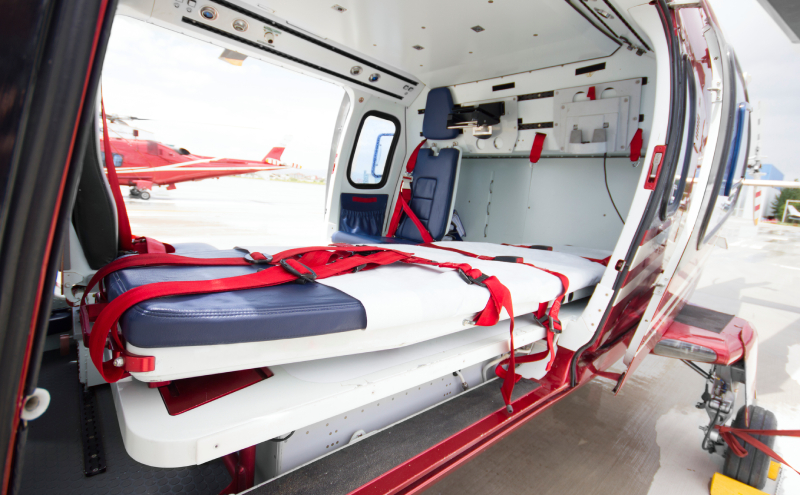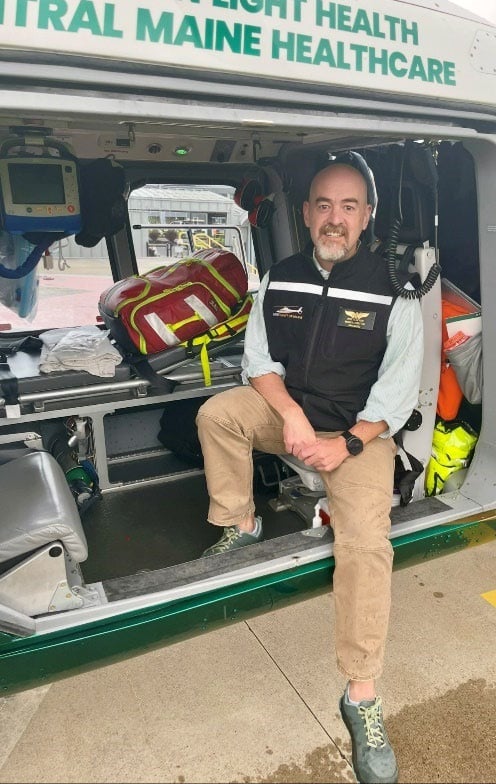
Medical Direction in Critical Care Transport: A guide to an emergency physician’s involvement
By: Dr. Peter Tilney, DO, FACEP, FFAEM, EMT-P
Chair-Elect of the ACEP Air Medical Transport Section
So, you have been working in Emergency Medicine (EM) for a while, or perhaps you are making your way through medical training or residency, and somehow, you have been asked to be involved with a transport team or are interested in critical care medical transport. How do you start? There are a variety of established pathways to reach this goal, but perhaps you are mid-career or are even a medical student figuring out your long-term trajectory. Whatever the reason, our ACEP Air Medical Transport Section has some thoughts and suggestions to make this all easier. Let’s start with some basics.
In the realm of out-of-hospital care, there are Emergency Medical Services (EMS) providers, including Emergency Medical Technicians (EMTs) and Paramedics who only respond to 911 calls or do emergency response with their affiliated agencies and are responsible for bringing patients to the nearest emergency departments (emergency or “scene” response). Most EM physicians are familiar with their local EMS agencies. Additionally, there are also out-of-hospital teams and responders who transfer patients between facilities. These interfacility transfers or IFT responses may include transfers between emergency departments (i.e., small ED to larger tertiary center EDs) or inpatient units. Many EMS agencies may even do a combination of both 911 scene response and interfacility transfers. To further illustrate the complex nature of the out-of-hospital arenas, interfacility transfers can be separated into different levels of response based upon the clinical complexity of the patient, the required staff that need to be used during the transfer (i.e., RN, respiratory therapy, perfusionist, physicians, or other required personnel), equipment needed, and care required to be done during transfer.
Moving patients between facilities can be quite complicated since the care provided in the back of the vehicle is essentially a continuation of care started at the sending hospital rather than protocolized care that is standard in typical scene response. To that end, many different types of teams have been developed to meet the needs of the patient. Under EMTALA, it is the responsibility of the sending provider to determine the level of expertise needed to be done during transport. For most transfers, a standard basic life support (BLS) crew may be sufficient, but as the complexity of the patient needs continues to grow, the appropriate teams, including Advanced Life Support (ALS) providers and those providing critical or specialized providers, may be required. In the realm of critical care or specialized transport (SCT), many of these teams are composed of a nurse and paramedic with a background in emergency and critical care medicine. These providers are typically trained in advanced pharmacology, including the use of vasopressor therapy, the administration of blood products, and, in many instances, rapid sequence intubation (RSI). Additionally, these teams have extensive experience in the use of critical care equipment, including ventilators and extracorporeal membrane oxygenation (ECMO). With their specialty training, other staff that were typically needed for these transports, including physicians, respiratory therapists, and even perfusionists, may be excluded from some of these transfers.
In some parts of the country, additional specialty care transport programs have been developed to transfer patients who require a very specific skill set. These populations include neonatal, pediatric, and even, in some cases, those patients requiring emergent organ transplants. These specific patients may require support from a physician or special team member during their time in the out-of-hospital environment. The staff that work on these types of transfers bring a wealth of knowledge to their patients that may not be rivaled by other provider staff. Additionally, the training that occurs with these individuals is resource-intensive and only occurs in facilities that have enough of a catchment area to support a program to this level.
The training required for critical care transport teams is unparalleled compared to other EMS services. Providers who work on these teams are only hired if they can document significant work experience in relevant venues. For paramedics, it is imperative that they have experience with critically ill patients from relevant 911 scene response or previous work as a specialty team provider. On the nursing side, intensive care experience (medical ICU or subspecialty care including cardiac, trauma, or surgical ICU) or experience in the emergency department is also imperative in the basic training of critical care transport staff. Once hired, these providers will use a combination of patient experience in relevant clinical areas to augment knowledge gained from didactics and ongoing education. In recent years, high-fidelity simulation has also been incorporated into the basic and ongoing providers working on critical care and specialty care transport teams. These individuals demonstrate a high level of clinical knowledge experience, allowing them to work in a more independent practice model than other EMS or inpatient circumstances.
Lastly, what sets out many critical care teams is the mode of transport used. Due to some of the time-critical nature of illnesses and injuries that many of these entities encounter, the use of medical aircraft (i.e., helicopters and fixed-wing assets) is used routinely. Additionally, specialty teams may also use highly that can accommodate specialty medical equipment that has space, size, and other specific requirements and restrictions. Initially, many providers report that the reason that they were attracted to critical care transport was the use of these specialized transport assets, but once they have acclimatized to the daily working venue, many staff report that the medicine provided is actually the reason that they remain dedicated in their specialty.
With all of this background, what is the exact role of the medical director? Well, it depends. The medical director is essentially the coordinator of the medicine provided in the out-of-hospital environment. To do this successfully, the role of this person or people is to work with crews in a prospective and retrospective fashion. The medical director is responsible for the care provided at the bedside. Prospectively, they will develop protocols, guidelines, and care plans that outline what is provided during the call. This information generally matches what is deemed as the standard of care so that staff are providing similar or advanced care compared to what the patient received from the sending facility. To do this successfully, the medical director or medical direction team must be familiar with the latest literature and guidelines to match developments in clinical care medicine. Additionally, it is also the medical director's role to ensure sufficient staff to provide online medical direction to address any issues in care as the transfer ensues. That can be done by having a designated medical staff member available for consultation or by planning with the sending/receiving providers willing to provide real-time online medical direction. In many cases, it is a combination of the medical director (s) who are aware of the transport and abilities or limitations and the providers with specific knowledge of the clinical care provided.

From the retrospective side, medical directors are also responsible for the care that is provided by their teams. High-functioning medical director oversight involves not only retrospective review but also examining trends identified over time to address any inadvertent “drift” in clinical care at the bedside. This can include relevant omissions in care or even cases where transport providers include care that is not outlined in protocols or guidelines. Over the long term, there has been a move to compare the care provided among agencies. In critical care transport, the GAMUT (Ground Air Medical qUality in Transport) group was developed to enable a group of medical directors to compare metrics around critical care transport. Other groups have been developed in a similar fashion to ensure quality care is being provided in a challenging environment.
Unless you have or are planning to do a fellowship in emergency medical services, the resources available to medical directors may not have fallen in your lap. There are a variety of organizations that are too numerous to list, but I have included a list in the first appendix (Appendix A. Organizations involved in critical care interfacility transport. The first group to investigate is the National Association of EMS Physicians (www.naemsp.org). This group is interested in promoting EMS leadership in providers and provides information about developing skills in EMS medical direction and EMS management from the provider perspective. Accompanying the information at NAEMSP is the Association of Air Medical Physicians (www.ampa.org). AMPA is the largest group of physicians involved in air medical and critical care transport. There are a variety of providers who belong to this organization, ranging from emergency to internal to critical care medicine, and the group is also dedicated to advancing a high level of medical oversight for medical transport. Lastly, another group focused on managing specialty care transport is the Association of Critical Care Transport (www.acctforpatients.org). This non-profit agency ensures patients have access to the highest quality of care in critical care transport. These organizations, in combination with others noted in the appendix, are the cornerstones of critical care transport and the management of these teams.
As a newly involved physician in the realm of critical care transport, it is imperative that not only one have a high-level understanding of what a critical care transport service is but also how these services fit into one’s local landscape. The medical director has an imperative role in the function and oversight of these services. Medical transport is a physician-prescribed event. Ultimately, the care provided during transfer is the responsibility of the sending provider, but the medical director is involved in all the key aspects of the transport to ensure that the patient arrives safely at their destination.

